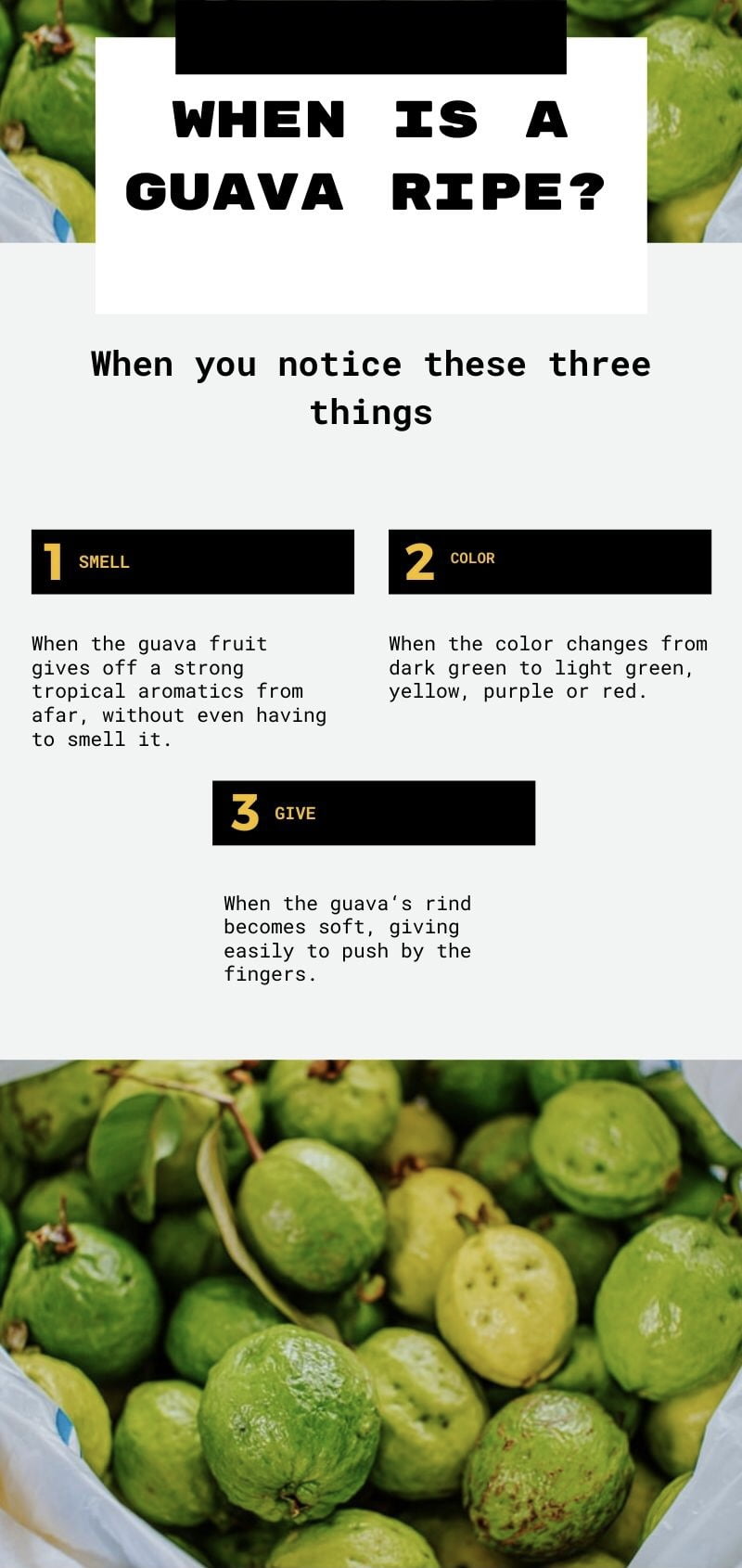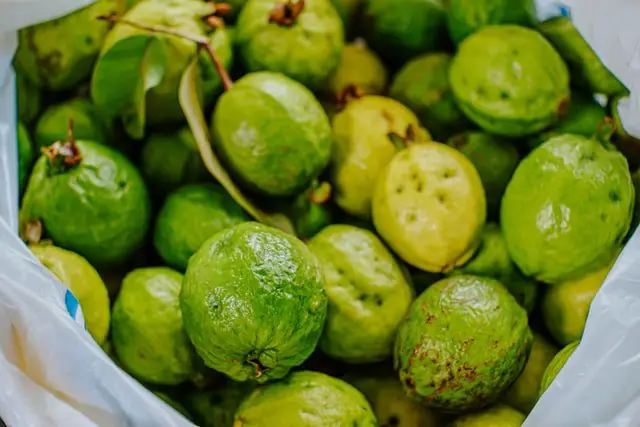It’s way past 2 years and the shrubs are starting to fruit, its only right that you are bothered on how to pick the berries after such as long wait. Or, maybe you’re only visiting the farmers market, and you’re hoping to bring back juicy and tasty guavas for the family to devour. Either way, we got you covered with this article.
Not only will you learn how to isolate succulent guavas from the sturdy culprits, you’ll also learn how to mature unripe guavas when you accidentally (or purposely) pick one, how to consume them healthy and nicely and also how to store them in the house for long term use. Let’s get into it.
When is a guava ripe?
A guava fruit is ripe when the rind yields slightly to pressure applied by the fingers; similar to a freshly ripe banana fruit or a mature sugar baby watermelon, and also exudes a bright tropical aromatics noticeable from a short distance away.
Another sign of a ripe guava berry can be traced all the way to its skin. Apple guavas, the most common type of guavas, transition from dark green to lighter shades of green, or even bear a golden to pale yellow tinge frequently blushed with small pink or red. One variety of guava known as the Red Malaysian guava however, have rinds that take on a dark purple-brown hue when they fully ripen.
The common guava fruit
What most of us refer to as guava is the Psidium guajava, popularly known as the apple guava, common guava or the lemon guava. This is the most widely consumed species of fruits mapped under the “guava umbrella” which contains more than 100 different shrubs.
The apple guava itself is a family of different types of cultivars unequally popular across different regions of the world. Cultivars are basically (but not always) an improved version of a parent species, in this case, the apple guava. Some of the cultivars include; the Red Malaysian guava, the Mexican cream guava, and the pink guava.
The rind of the apple guava starts out green on the shrubs and convert into a yellow, red, pink, or light green skin depending on the variety. The ripe fruits exude a smell that is strong, sweet, and musky and their taste is typical of how they smell, sweet and flavorful although some varieties are sour.
Overripe fruits savor even more and bear a darker shade of color. You need not bring the berries to your nostrils for a whiff. The impatient mellow would eagerly invite you from a distance away.
Under the skin of a ripe apple guava is a thick layer of somewhat granular gritty flesh — off-white, yellowish, pink, or near red in trace and having a darkly colored central pulp that is juicy and typically filled with hard but chewable seeds, except for the seedless varieties.
Scent, feel and color are basically how you tell a ripened guava fruits on the backyard shrubs or those staked up at the market counters.
Other tips:
- The rinds of a ripe guava fruits are slightly soft, resisting push only by a fair degree, unlike those of the premature berry. They are also non sticky and acerbic in taste unlike the green counterpart.
- The fact that guavas have a really strong stench even from a reasonable distance away doesn’t mean you shouldn’t actually smell them to tell how ripe they are. That’s actually the most crucial of all steps to identifying a ripened berry. Unripe guavas rarely give off smell, except for the pineapple species.
- Most guavas displayed at the market shelves are the ones that are “just starting to ripe”. And virtually all of them are coated with edible wax to delay ripening and extend shell life. When you get your hands on one of these and have intentions of devouring them anytime soon, wash them clean under a running tap and store in a paper bag together with an unripe banana or apple to speed up ripening. If you like, you can also enjoy them as they are.
- For gardeners: Because guavas are one of the many fruits that continue to ripen even after they are harvested, it is advisable to pick them up from the shrubs before they fully ripen and store them plenty in the freezer to delay ripening and keep them fresh for up to 8 months. Fully ripened guavas left on the trees can easily harbor fruit fly or moth growth, or begin to rot. When they are harvested clean, they can be stored in the refrigerator for up to 7 days, depending on the level of doneness.
- For gardeners: There’s no specific harvest period for guavas. The fruits can ripen on the tree year round in warmer climate, so gauging them based on time of the year wouldn’t work. Just stick with the smell, feel and rind color tests.
- For store bought guavas: Always pick guavas that are blemish free. They’re the best in terms of quality.
Other species called “guava”
Some of the unpopular species also called guavas include the strawberry guavas and the pineapple guavas.
The strawberry guava also called the cattley guava or the cherry guava is a small fruit averaging 2 to 4 centimeters, native to Brazil but also popular in the North, and having a round to oval shape. They start out bright green on the trees and eventually turn into variegated hues of maroon, pink, and dark red. This facts ensures that ripe strawberry guavas are easily pinpointed from developing ones, that’s before they fall off though. Because when they do, it’s much more easier!
Another method to tell ripened strawberry guavas from the unripe ones, though unnecessary, is by the bright, tart and tangy notes that they exude. The fruit has a sweet, fruity, and floral flavor reminiscent of roses and strawberries – why they are called strawberries in the first place.
On the other hand, the pineapple guava is oblong and slightly egg shaped and sized. The alternate names are feijoa and guavasteen. The fruit starts out green and ends up green. The inside is divided into a white or opaque, gritty flesh immediately after the skin and a clear, gelatinous seed pulp in the middle. Its taste is a note of pineapple, apple, and mint and the smell is distinctive and potent, resembling a fine perfume.
Identifying the ripened fruit of this guava species is easy because it falls off to the ground at its fullest flavor. The fruit can also be picked prior to this level of ripening to prevent bruising and infestation by guava moths.
How to eat guavas
All parts of the guava fruit are edible, from the bumpy glossy skin to the tiny tough seeds that pattern the flesh’s core. Feel free to bite into the complex world of flavoring packed within the berry; a skew from floral, fruity to a musky, sour note that tingles the corpus collsum. Guavas are ready to eat when they’re just starting to soften on the outside and their stench are beginning to go noticeable. You can always leave them to ripen a bit more, but you risk rotting or over-ripening the fruit.
One species of the guava, the pineapple guava, has petal that are even edible. Whenever you feel the need for a special ingredient in your dressings, add the slightly sweet petals from the backyard for an unforgettable kick and enjoy with your family and friends. The petals have a cinnamon kind of hint.
Guavas can also be made into juice, for example this elegant recipe that we absolutely love!
How to cut guavas
If you’re the type that loves to eat fruits with style, slice your guavas as you would an apple, and devour the pieces on a massage couch one after the other. Or, you can serve them in ice cream or yogurt, or bite chunk after chunk as you would, still, and apple. Either way, your choice!
Happy guava hunting!
Quick card on how to tell when a guava fruit is ripe:



